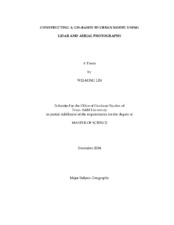| dc.description.abstract | Due to the increasing availability of high-resolution remotely sensed
imagery and detailed terrain surface elevation models, urban planners and
municipal managers can now model and visualize the urban space in three
dimensions. The traditional approach to the representation of urban space is 2D
planimetric maps with building footprints, facilities and road networks.
Recently, a number of methods have been developed to represent true 3D urban
models. Those include panoramic imaging, Virtual Reality Modeling Language
(VRML), and Computer-aided Design (CAD). These methods focus on aesthetic
representation, but they do not have sufficient spatial query and analytical
capabilities.
This research evaluates the conventional approaches to 3D urban models,
and identifies their advantages and limitations; GIS functionalities have been
combined with 3D urban visualization techniques to develop a GIS-based urban
modeling method; The algorithms and techniques have been explored to derive
urban objects and their attributes from airborne LiDAR and high-resolution
imagery for constructing and visualizing 3D urban models; and 3D urban
models for the Texas A&M University (TAMU) campus and downtown
Houston have been implemented using the algorithms and techniques
developed in this research. By adding close-range camera images and highresolution
aerial photographs as the texture of urban objects, effect of
photorealism visualization has been achieved for walk-through and fly-through
animations.
The Texas A&M University campus model and the downtown Houston
model have been implemented to offer proof-of-concept, namely, to
demonstrate the advantages of the GIS-based approach. These two prototype
applications show that the GIS-based 3D urban modeling method, by coupling
ArcGIS and MultiGen-Paradigm Site Builder 3D software, can realize the
desired functionalities in georeferencing, geographical measurements, spatial
query, spatial analysis, and numerical modeling in 3D visual environment. | en |


